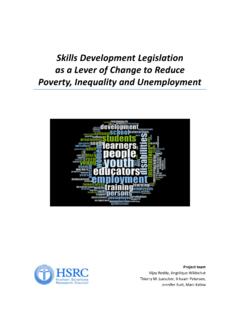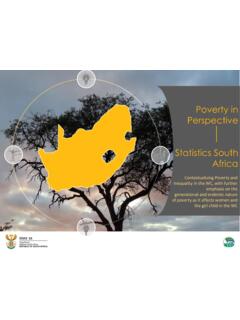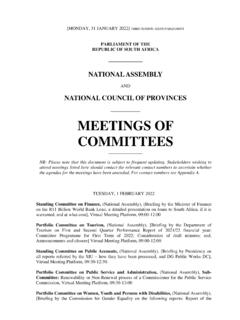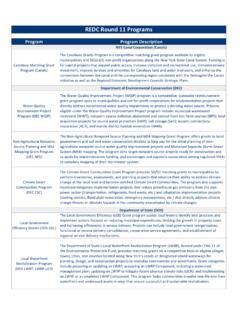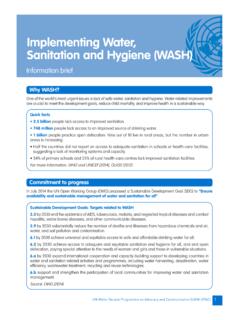Transcription of OVERVIEW OF THE DISTRICT DEVELOPMENT MODEL A …
1 21 August 2020. OVERVIEW OF THE DISTRICT DEVELOPMENT MODEL A FRAMEWORK FOR. CO-OPERATIVE SERVICE DELIVERY. TABLE OF CONTENTS. 1. Introduction and Background .. 1. 2. OVERVIEW of the DISTRICT DEVELOPMENT MODEL .. 2. Objectives of the DDM .. 2. Alignment of the DDM with other DEVELOPMENT -oriented 3. 3. Constitutional dimensions of the DISTRICT DEVELOPMENT MODEL .. 5. 4. OVERVIEW of the Service Delivery challenges A case of water services .. 6. 5. Conclusions and Issues for consideration by parliament .. 7. 6. References .. 8. 1. INTRODUCTION AND BACKGROUND. The purpose of this paper is to provide an OVERVIEW of the DISTRICT DEVELOPMENT MODEL by providing its meaning, constitutional dimensions, alignment to other DEVELOPMENT - oriented policies, and a cursory look at service delivery challenges in South Africa. The overall aim is to deepen the knowledge and understanding of the Members of Parliam ent on the DISTRICT DEVELOPMENT MODEL .
2 State of the Nation Address 2019 (SONA 2019) identified the pattern of operating in silos as a challenge, which led to a lack of coherence in planning and implementation and has made monitoring and oversight of government's programme difficult. The consequence has been non-optimal delivery of services and diminished impact on the triple challenge of poverty, inequality, and unemployment. 1 In light of this challenge, President Cyril Ramaphosa launched the DISTRICT DEVELOPMENT MODEL in 2019. Three DISTRICT DEVELOPMENT MODEL pilot projects were launched as follows the rural version at the OR. 1. Ramaphosa (2019). Research Unit | Author: Thomani Manungufala Authors contact details: (021) 403 8335 1. Tambo DISTRICT Municipality in the Eastern Cape Province on 17 September 2019; the metropolitan version at the eThekwini Metropolitan Municipality in the Kwazulu Natal Province on 18 October 2019; and the mining version at the Waterberg DISTRICT Municipality in Limpopo Province on 26 November 2019.
3 2. 2. OVERVIEW OF THE DISTRICT DEVELOPMENT MODEL . The DISTRICT DEVELOPMENT MODEL (DDM) is a new integrated DISTRICT -based approach to addressing service delivery challenges through, among others, localised procurement and job creation that promotes and supports local businesses, and involves local communities. It calls for One DISTRICT , One Plan, and One Budget. 3. It aims to accelerate, align and integrate service delivery under a single DEVELOPMENT plan per DISTRICT or metro that is developed jointly by national, provincial, and local government, as well as business, labour, and community in each DISTRICT . It furth er ensures that national priorities, such as economic growth and employment; improvements to living conditions;. the fight against crime and corruption, and better education outcomes are attended to in the locality concerned. This DEVELOPMENT approach ensures that planning and spending across the three spheres of government are integrated and aligned and that each DISTRICT or metro plan is developed with the interests and input of communities taken into account OBJECTIVES OF THE DDM.
4 The above description of the DDM encapsulates some of its objectives. Below is a summary of the specific objectives 5 of the DDM. Solve the Silos at a horizontal and vertical level;. Maximise impact and align plans and resources at our disposal through the DEVELOPMENT of One DISTRICT , One Plan, and One Budget;. 2. The Presidency (2019). 3. DPME (2019). 4. DPME (2019). 5. Department of Cooperative Governance and Traditional Affairs (2020). Research Unit | OVERVIEW of the DISTRICT DEVELOPMENT MODEL Page 2 of 9. Narrow the distance between people and government by strengthening the coordination role and capacities at the DISTRICT and City levels;. Ensure inclusivity by gender budgeting based on the needs and aspirations of our people and communities at a local level;. Build government capacity to support to municipalities;. Strengthen monitoring and evaluation at DISTRICT and local levels.
5 Implement a balanced approach towards DEVELOPMENT between urban and rural areas;. Ensure sustainable DEVELOPMENT whilst accelerating initiatives to promote poverty eradication, employment and equality; and Exercise oversight over budgets and projects in an accountable and transparent manner. These objectives are all set to accelerate service delivery challenges. ALIGNMENT OF THE DDM WITH OTHER DEVELOPMENT ORIENTED. POLICIES. Contrary to the popular view that the DDM conflicts with other service delivery oriented policies (plans, frameworks, regulations, etc.) such as the Integrated Developmen t Plans (IDP), Integrated Urban DEVELOPMENT Framework (IUDF), Spatial DEVELOPMENT Frameworks (SDFs), it is not as it seeks to complement them. These policies complement each other in addressing major social, spatial, and economic challenges in line with t he goals outlined in the National DEVELOPMENT Plan (NDP).
6 The NDP calls for the elimination of poverty, unemployment, and inequality. 6 The IDP, IUDF, SDF, and other policies, legislations, and previous similar programmes, the DDM. seeks to ensure maximum coordination and cooperation among all three spheres of government. For example, the DDM will be implemented through a collaborative pro cess to develop One Plan for all 44 districts and 8 Metropolitan Municipalities which will be further synchronized with IDPs of these municipalities. It is therefore clear that the DDM. will neither replace nor duplicate the work of other plans within munic ipalities. To illustrate the alignment and complementarity of the DDM with other plans or frameworks, IUDF provides a clear example. The IUDF is a National Urban Policy that 6. National Planning Commission. (2012). Research Unit | OVERVIEW of the DISTRICT DEVELOPMENT MODEL Page 3 of 9. marks a New Deal for South African cities and towns.
7 It seeks to steer urban growth towards a sustainable MODEL of compact, connected, and coordinated towns and cities. It provides a roadmap to implement the NDP's vision for spatial transformation creating liveable, inclusive, and resilient towns and cities while reversing the ap artheid spatial legacy. 7. The DDM provides a pathway to enhancing the implementation of the IUDF, for example, one of the short term priorities of the IUDF is to institutionalise long -term planning. The DDM, through the introduction of the One Plan, is on course to make this a reality. While the IUDF advocates for greater involvement of Premiers and MECs in planning and DEVELOPMENT , the DDM also advocates for the same intervention across all three spheres of government, the recent nomination of political DISTRICT champions at a national level that cascades to DISTRICT level are a perfect example of how the IUDF and the DDM.
8 Complement one another. 8. The IUDF assists with focuses in cities and towns while the DDM takes on a DISTRICT -wide approach. The complementarity can be seen in the sense that, the IUDF provides a more granular focus within a DISTRICT , cities and towns, while DDM takes on a regional posture. This may also mean that IUDF interventions in cities and towns will be critical to providing a DISTRICT -wide perspective, especially in areas of integrated urban planning and management, integrated sustainable human settlement, integrated urban infrastructure, efficient land governance and management, inclusive economic DEVELOPMENT , among many others. 9 It appears the perception that the DDM replaces and duplicates other DEVELOPMENT -oriented policies is unfounded. 7. IUDF (2019). 8. Ibid. 9. Ibid. Research Unit | OVERVIEW of the DISTRICT DEVELOPMENT MODEL Page 4 of 9. 3. CONSTITUTIONAL DIMENSIONS OF THE DISTRICT DEVELOPMENT MODEL .
9 The DDM falls within the ambit of Chapter 3 and 7 of the Constitution on Co -operative Government and Local Government, respectively. It is based on Section 41 (h) (i -vi) and Section 154 (1) of the Constitution, 1996. Cooperative Government, and Local Government Section 41 (1) principles of co-operative government and intergovernmental , (1) All spheres of government and all organs of state within each sphere must (h) co - operate with one another in mutual trust and good faith by (i) fostering friendly relations;. (ii) assisting and supporting one another; (iii) informing one another of, and consulting one another on, matters of common interest; (iv) coordinating their actions and legislation with one another; (v) adhering to agreed procedures; and (vi) avoiding legal proceedings against one another. Section 154 (1) Municipalities in co-operative (1) The national government and provincial governments, by legislative and other measures, must support and strengthen the capacity of municipalities to manage the ir affairs, to exercise their powers, and to perform their functions.
10 DDM seeks to encourage cooperative governance between local, provincial, and national spheres of government. It provides a framework for the provincial and national spheres of government to amicably intervene in the business of local government. It is a proactive intervention by the national and provincial governments to support and strengthen the capacity of municipalities to manage their affairs and to accelerate service delivery. It is not reactive and adversarial like Section 139 of the Constitution which provides for a Provincial intervention in local government when there is already a poor to none delivery of services by a municipality. It is on this basis that the DDM is lauded as t he framework for accelerated service delivery in the local government. Research Unit | OVERVIEW of the DISTRICT DEVELOPMENT MODEL Page 5 of 9. 4. OVERVIEW OF THE SERVICE DELIVERY CHALLENGES A CASE OF water .

